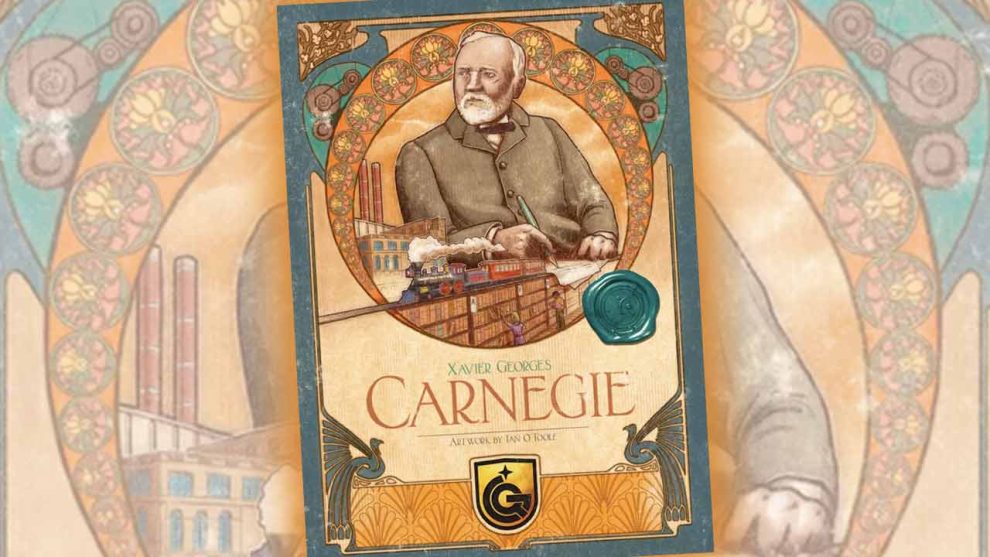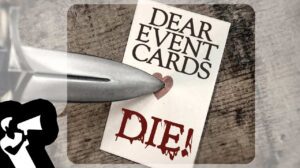Carnegie (2022, published by Pegasus Spiele in North America) had an interesting journey, from its time in a crowdfunding campaign to my doorstep.
As I highlighted in my article about Board Game Arena (BGA), Carnegie was made available to the masses during its Kickstarter. Whereas many games have free implementations on Tabletop Simulator or Tabletopia, Carnegie was built in the BGA environment and it was significantly easier to interact with thanks to BGA’s superior UI.
As a result, I played Carnegie 17 times on BGA. I had the chance to play it solo (16 of the 17 times) and with a friend in one of my gaming groups as a two-player experience. I thought it was good, but wasn’t ready to drop money on the game’s deluxe version plus shipping. However, I knew that eventually I wanted to see how the online game experience translated as a physical version.
I’m excited to share that the retail version of the game is excellent. The team at Pegasus Spiele was kind enough to send a review copy, and I really am surprised at how solid the retail version of the game is; the production is fantastic.
You can get your hands on one of the year’s best games for a reasonable price. Carnegie has a novel action selection system paired with its very Euro milestone system—Donations—which all translate into a very satisfying mid-weight experience.

The Late 1800s?
It’s the age of businessman and philanthropist Andrew Carnegie, and players take on the roles of entrepreneurs trying to build a business from the ground up.
Even now, I’m not really sure what the backstory is for this game. The game is about Andrew Carnegie, but none of the players are playing as Carnegie himself. It’s not really clear what year it is—Carnegie made his name during the back half of the 19th century, but this game features running a business with an elevator in its lobby, plus stagecoaches, carts, and locomotives as a means of moving Employees around the game board. Let’s go with the late 1800s, then?
Games of Carnegie revolve around scoring points by doing a few different things. You want to be the best at building a network of connections across the continental US. By making Donations, players can ensure end-game points by spending cash at certain points in the game. Your Research & Development (R&D) Department allows for the development of Project Tabs. Building Departments beyond your starting set of locations gives you both chances to build more buildings, as well as potentially scoring points by the end of play.
It’s a lot, or maybe, it just sounds like a lot. When you first set up the game, read through the rulebook, and navigate what’s possible on each turn, it looks like it will be a beast. But the actions are straightforward, the game is relatively easy to teach, and the term “easy to learn, difficult to master” comes to mind as you work through your first couple of plays.
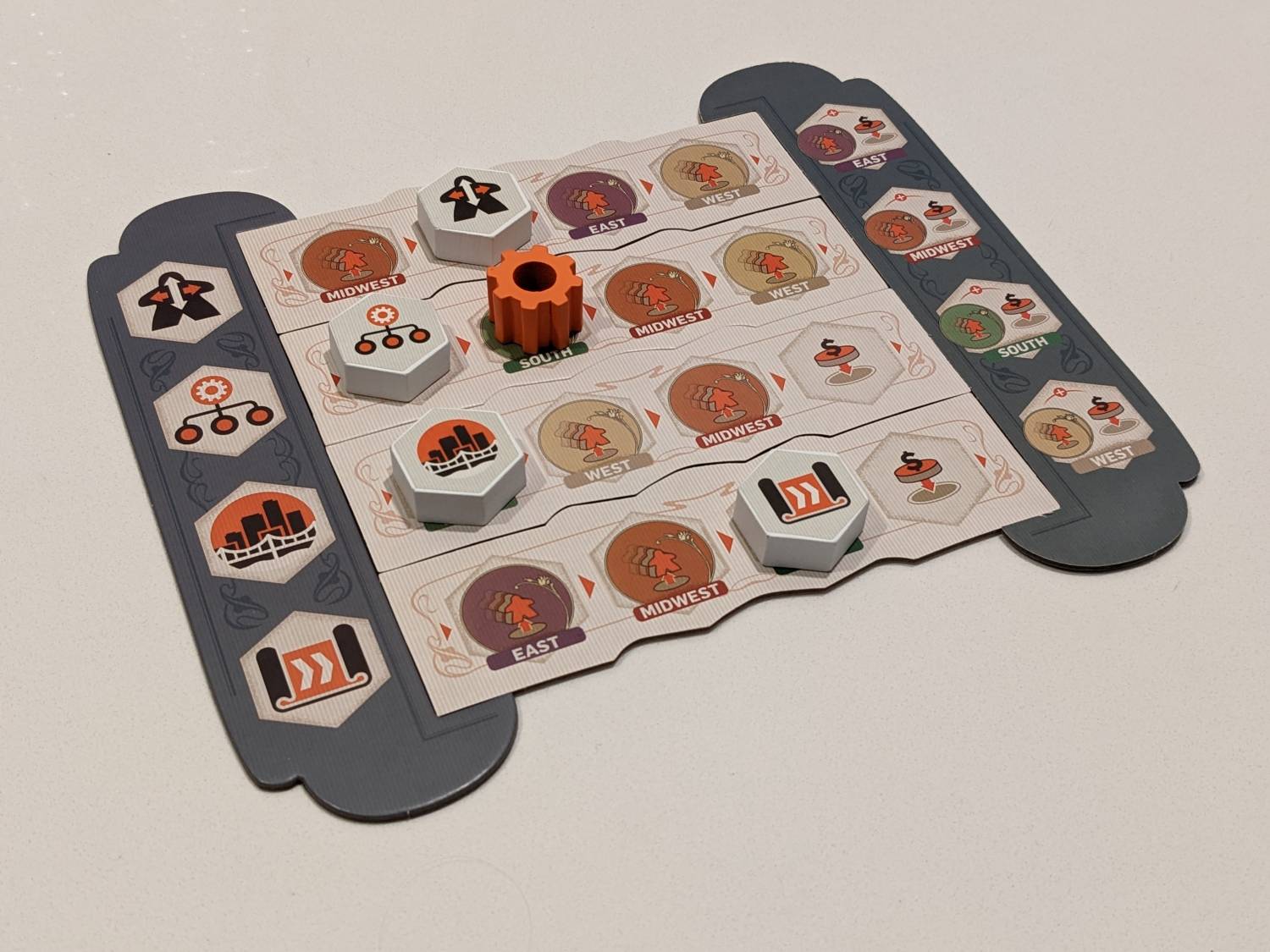
The genius of Carnegie comes from the action selection system, known as the Timeline. A game of Carnegie takes place over 20 rounds; in a round, one player is the active player, and that player selects one of the four Departments in the game: Human Resources (HR), Management, Construction, and R&D. Picking an action triggers an Event, which is either the Donation system I mentioned earlier or an Income round, tied to one of the map’s four regions.
One of the best puzzles in Carnegie comes from the Income sequence. Employees that were previously sent out on “Missions” can return home, generating cash, goods and maybe new Employees if at least one employee is sent back to a player’s company board. But having Employees in the proper regions, planning far enough ahead to return Employees at just the right time, is one of the more satisfying moments in Carnegie. It feels great when you line up everything just right.
(The term “Mission” may be the only part of the game that was lost in translation when this game was spun into English; would anyone send their sales team on a “Mission”???)
After the Event (Donation or Income) is resolved, the active player takes the first action of the selected Department. Then, each other player has to follow the active player’s action choice, and can play if they have any active Employees in that Department.
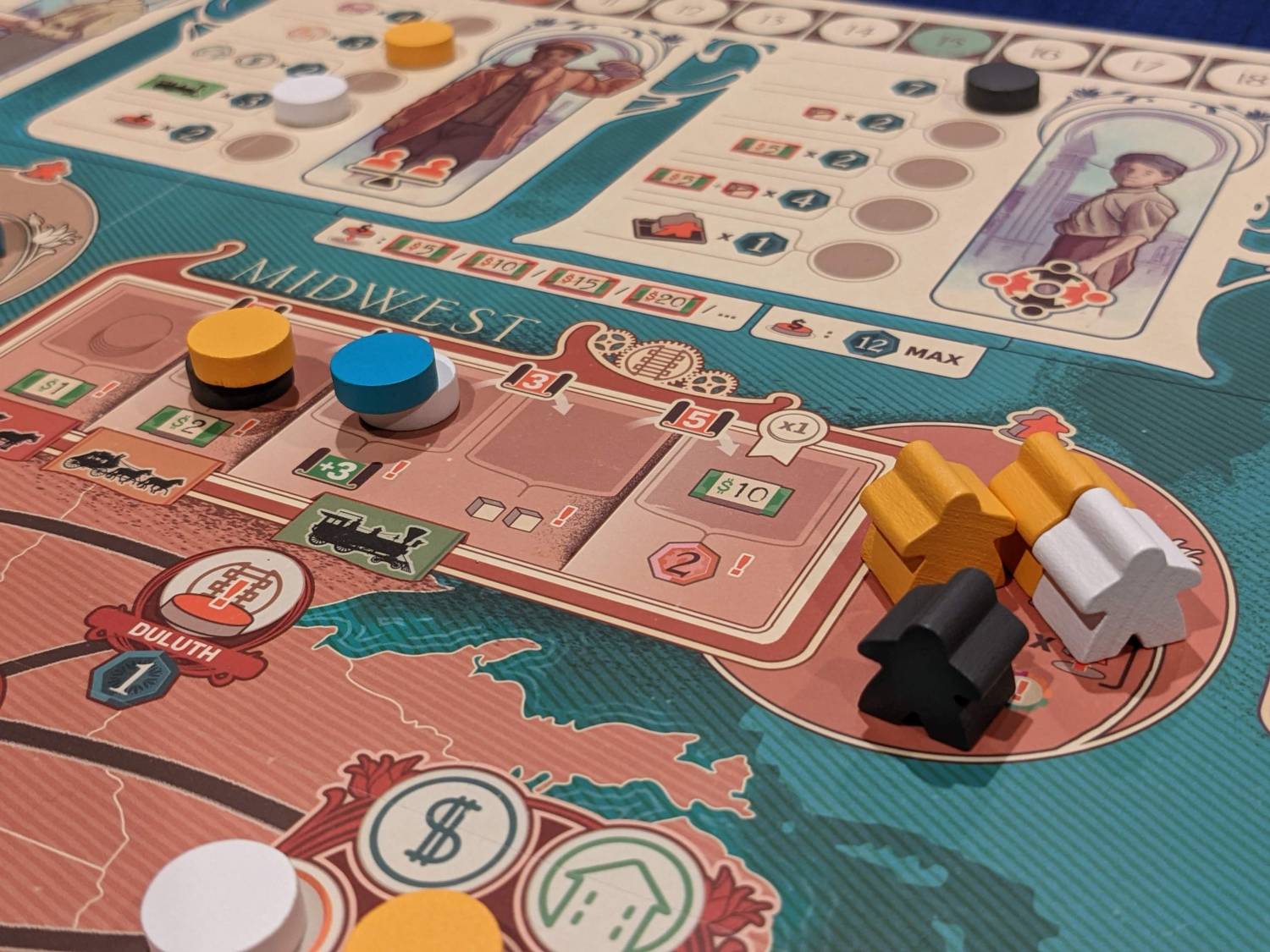
R&D lets players advance on tracks in any of the four regions, which could spike a future round’s income. R&D also provides more buildings for the Construction Department on later turns. R&D is the most important Department in the game.
The other Departments do what you’d expect. HR provides for training, or retraining, of new Employees by providing movement points to get people into other parts of your 15-space Company. Management sends Employees out on Missions to provide instant cash and/or goods, as well as manage the slots in your company by providing new Departments to use during matching actions later.
Construction generates the main area control mechanics of Carnegie. By dropping building projects across the US, players can get instant income bonuses, end-game scoring for building in certain cities, and chances to build a network of city connections that can score a massive point bonanza if you are able to connect all four regional hubs with point-to-point connections.
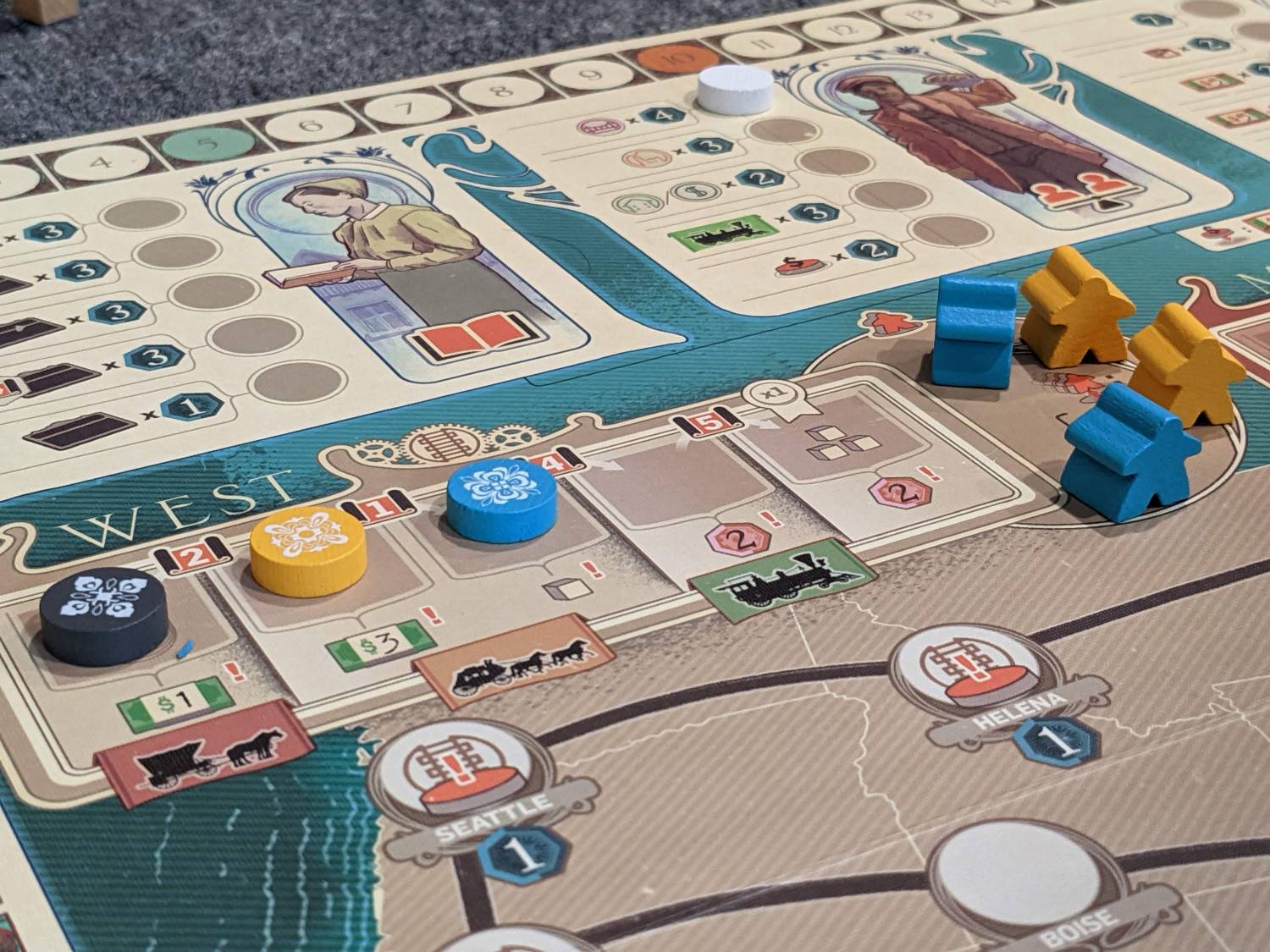
“Double HR”
The best part of the Timeline: trying to figure out which of the four Departments a player will pick on their turn.
Sometimes, it’s easy to forecast: all players might have a bunch of Employees in their respective lobbies, and no other way to take a meaningful action or make a donation without using HR to move people around.
Sometimes, it’s a hedge: you don’t know what your neighbor Alec is going to pick, but you’ve got enough active Employees in each Department so that you can do something decent no matter which Department Alec picks on his turn.
And, occasionally, it’s a crapshoot: you think your “friend” Kev is going to pick R&D, and then, just after someone picks HR to move people around, Kev picks HR a second turn in a row.
“You [profanity deleted]!!” you blurt out. “Did you just go ‘double HR’ on us?”
But that’s just it, isn’t it? A player can survey the landscape, know what’s best for them, see what’s worst for you, and execute on their plan. Often, this leads to comedy.
Carnegie lets you get around this once per game, at least if you were the third player to play in a three-player game, or if you are in a full player count game of four people. In these situations, you’ll have access to a token that lets you pick a different action than the one that was selected by the active player once in the entire game.
The Timeline is the best part of Carnegie. It has a lot of the things that land well in a Euro game experience, but it’s this kind of interaction that really sings: you can still technically do an action, but is this the right time to do it? Hard to say. If you’ve planned well, you might be able to get around it, but it’s not a guarantee.
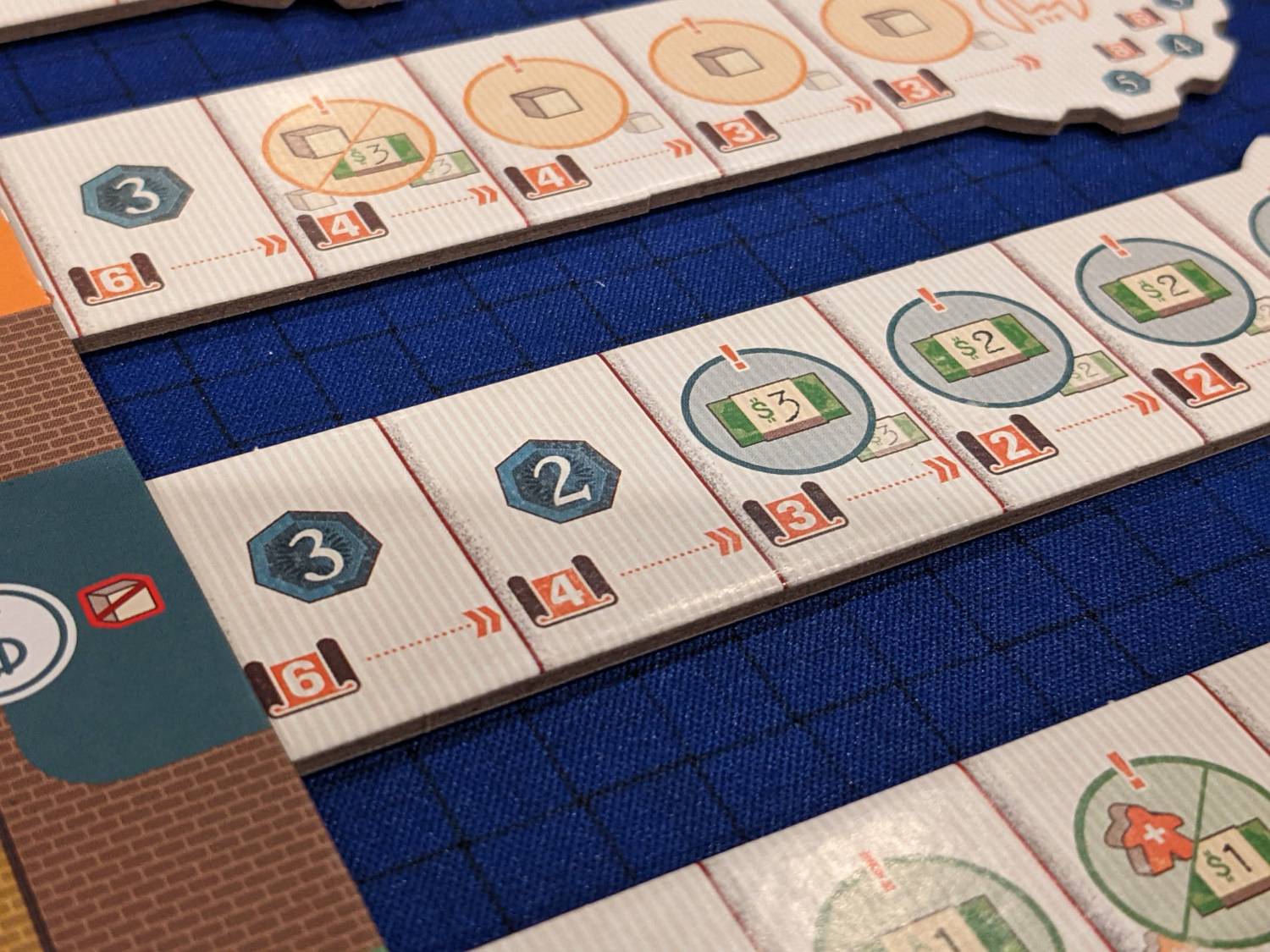
The Production
For a retail copy, the components of Carnegie are some of the best in the market.
Let’s start with the Company boards that each player has to start the game. This board is so thick that it accommodates the Project Tabs—cardboard slides which are slowly pulled out from the side to hold construction discs; it’s a really cool touch, andthe best physical component in the game.
The artwork is from Ian O’Toole, so another check in the box there. O’Toole’s work on the main board gives Carnegie such a striking table presence; the pictures I took for this article are decent, but seeing this “in real life” is something to behold.
The cardboard money tokens in the deluxe version of Carnegie are shiny, small, and, well, silly. The cardboard money in the retail version is actually better than the deluxe money, but in both cases, I use my Iron Clays for cash. (Seriously, people: poker chips.)
Coming back to the main board, the layout is excellent. The map of the US and the Donation sections are very easy to read from across the table. Super clean lines. The scoring summary in the bottom left-hand corner is fantastic.
Scores in Carnegie have generally fallen in the 100-150 range, with very little scoring taking place during games. This tells me a scorepad would have been the right call instead of a score tracker around the game board’s outer border, but this is a minor issue because the board is so well thought out.
The finish on the poker-sized solo deck cards also have a nice feel. (The solo mode is administered through cards. I haven’t played the physical game solo because the BGA version is so good.) The Timeline has lots of variety thanks to how it is constructed, ensuring that every game is a little different.
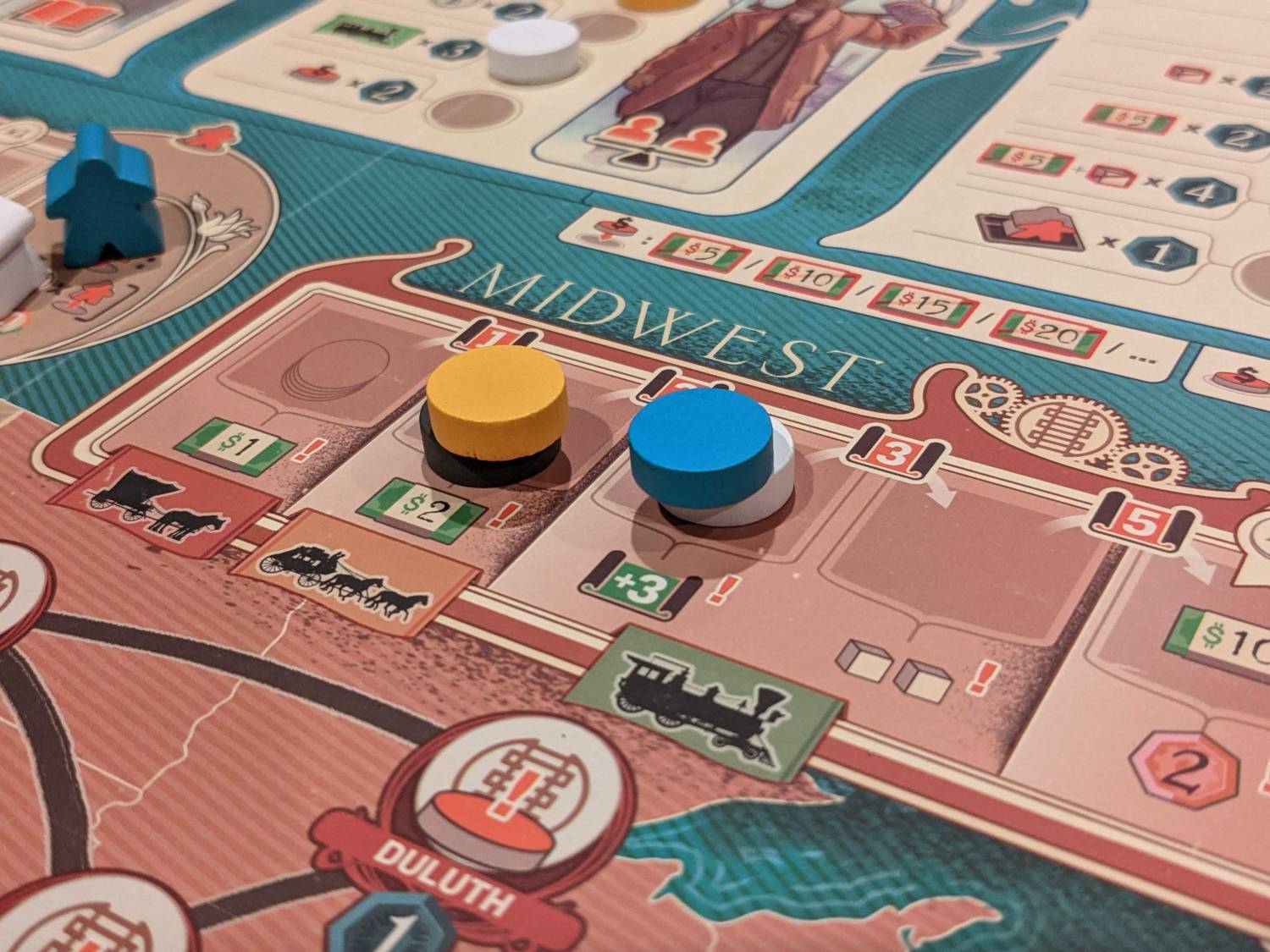
The Main Issue: R&D
My sense (after 20 games, 17 virtual and 3 in person) is that R&D is the most important Department in the game.
While some of the other Departments that can be added to the Company board are situationally strong, my games of Carnegie have usually featured a winner who was best at the R&D action. A couple of the Departments are upgrades over the starting R&D Department, and all the tracks are tied to R&D points being spent to make income stronger, or to add Buildings to your available supply.
I don’t think this is broken, but I do think some Departments are objectively better than some of the ones in, say, HR. That means that getting R&D Departments during the draft at setup—each player drafts a single Department that must be built first when taking a Management action—is a gold rush, especially when the random tile draw leaves only a couple of R&D Departments available for players.
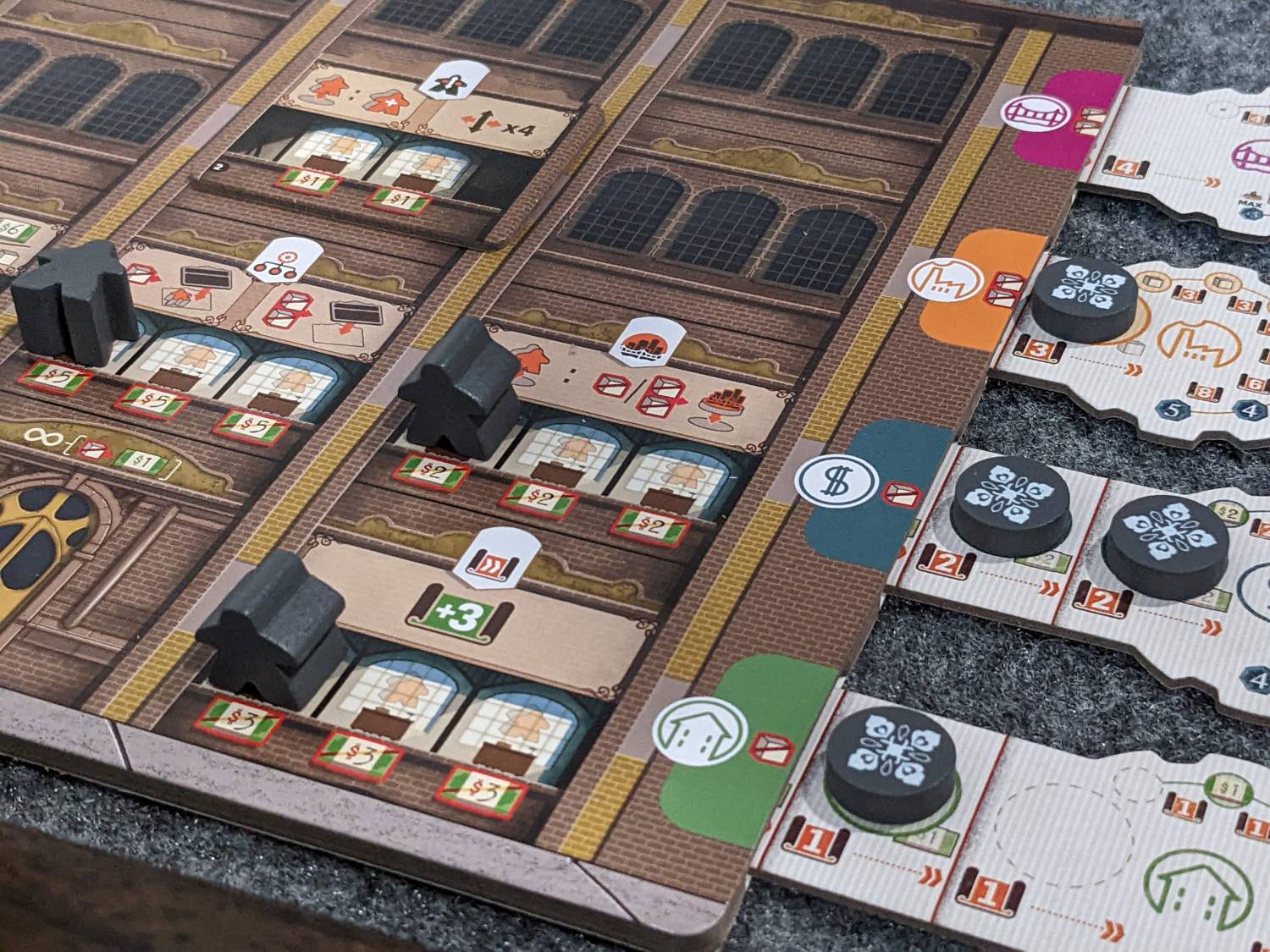
Yep, It’s a Winner
Carnegie is really good. Heavy strategy gamers love it as a mid-weight puzzle. Mid-weight Euro gamers love the Timeline; everyone loves the strong production qualities.
As much as I enjoy the physical production, I love that this game is available on BGA to try first in its complete form. Even the expansion Departments (which I have not played with yet) are available on BGA, so in a pinch, you can get your Carnegie fix when you would like, solo, with friends or complete strangers.
While I’m concerned about the weight of R&D’s Departments, this can be addressed by a good instructor when new players are sorting through which Departments are most valuable. Otherwise, Carnegie is a solid addition to any Euro gamer’s collection.


